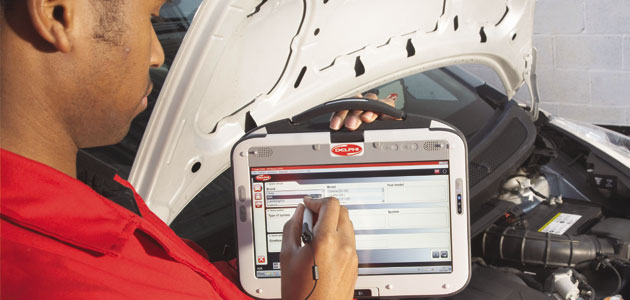
It’s fair to say that high-quality diagnostic equipment is one of the most valuable tools in a technician’s toolbox, but what if your equipment is providing unauthorised information? Delphi Automotive explains how you can identify pirated products and the pitfalls associated with them.
Software piracy is an increasingly growing counterfeit problem, where traders are cloning and selling OE diagnostics hardware and software to the aftermarket.

99% of counterfeit hardware and software is sold online
How is it done?
Specific to the hardware, the physical module is cloned to look exactly like the official branded hardware. The same holds true for the diagnostics software. Counterfeiters hack into the software programming, clone it and sell it with the cloned hardware or online. As experienced technicians will know though, a correct diagnosis depends on the accuracy of the information in the software and the ability of the hardware to take the correct readings from the vehicle.
In response to this increase in pirated hardware and software, Delphi has begun an aggressive anti-counterfeiting campaign. Part of the campaign’s focus is to educate the aftermarket, garage owners and technicians as to why software piracy is bad for their business.
Why is it bad for business?
Although the temptation to purchase a lower-priced unit may seem cost-effective in the beginning, it’ll more than likely end up costing more in the long term. Using pirated hardware and software could potentially compromise the vehicle’s integrity during diagnosis and repair, translating to more comebacks, as well as a potential safety risk.
Delphi also wants to reinforce the message to garages and technicians who may be tempted to use pirated software, that they risk damaging the hardware and invalidating their warranty. And, if they experience a problem after using pirated software or a counterfeit license, Delphi (or any other supplier, for that measure) will not be able to support the cloned product or pirated software.
Additionally, the campaign emphasises that Delphi will investigate and take action against software piracy, as well as shut down any software which has been unofficially licensed.
What questions should you ask?
Delphi software provides technicians with quick and accurate diagnostic solutions for thousands of vehicle maintenance problems. The information contained within the software is copyrighted, and it is illegal to access it without purchasing a license.
Therefore, can you be absolutely certain that your software contains up-to-date and valid information? Do you know for sure that your hardware is capable of running the correct tests and decoding the messages the car is sending it? If you bought your diagnostics hardware from an approved supplier, and have updated your official software with a valid ‘License Key’, then the answer is ‘Yes’.
Spot the difference?
 What is genuine and what is counterfeit? The following pointers should help you to avoid becoming the next victim of diagnostic piracy:
What is genuine and what is counterfeit? The following pointers should help you to avoid becoming the next victim of diagnostic piracy:
■ Only one of the logos (right) represents the official product. The logo on the right is of poor quality and is positioned poorly on the counterfeit device.
■ If you hold the device in your hand you can tell the difference immediately. The official Delphi product has an easy-to-grip rubberised black surface. The copy is made of cheap hard plastic.
■ The upper part of the official Delphi device is coloured in a smooth matt aluminium colour. The counterfeit product features a glossy speckled-silver coating.
■ The official Delphi DS150E VCI includes full Bluetooth connectivity – most unofficial versions do not. If your VCI is not Bluetooth enabled, that’s a sure sign that you’ve got an unofficial product.
■ On the back of the new VCI device, your 6-digit serial number should start with 30, and the bottom of the sticker should read ‘Made in Sweden.’ If your sticker says ‘Made in China’, then you have the counterfeit product. The CE mark is also fake, meaning that registered businesses using a counterfeit device are at risk of potential intervention under European law.
■ The weight of the official high-quality device is 485gm. The copied hardware uses cheaper, low-quality parts and only weighs 445gm. This is due to inferior quality components and missing functionality such as Bluetooth or flight recorder capability.
■ At the foot of the device, there is a microSD card which increases the device’s capability. If there is no card you will not be able to run the flight recorder – severely limiting your ability to diagnose correctly.
■ The DVD containing the unofficial software will normally not come on a genuine disc, and will often be printed with a cheap image. Do not use a counterfeit CD in your computer – there is a serious risk to your computer security if you do.
■ If your software asks you to run a separate activation program, then it is unofficial counterfeit software and will likely damage your PC.









